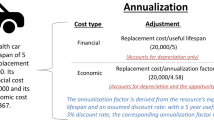Abstract
Despite renewed enthusiasm for the use of willingness to pay (WTP) in healthcare applications, there are still a lot of objections, resentment and scepticism regarding the desirability and feasibility of this technique. Objections can be classified into different categories: e.g. theoretical, feasibility of measurement, misunderstanding of economic concepts and emotional. In this commentary, I have tried to explain the nature of the ‘emotional’ objections to the use of WTP. I argue that such objections are not helpful and distract attention from the proper scientific debates about the important topics of theoretical foundation for economic evaluations and feasibility of measurement of individuals’ WTP. I believe that some of the emotional objections to WTP stem from perceptions about the relationship between the WTP measure and actual payment for health services. Hence, I discuss the use of the WTP methodology in 2 distinct contexts — cost-benefit analysis (CBA) and market research. Understanding the difference between these 2 most common areas of use will help alleviate objections based on emotions, allow us to use the technique where there seems to be no objections to its use (i.e. market research) and concentrate on the scientific debate where objections exist (i.e. the case of CBA).
Similar content being viewed by others
References
Johannesson M, Jonsson B. Economic evaluation in health care:is there a role for cost-benefit analysis? Health Policy 1991;17: 1–23
Pauly MV. Valuing health care benefits in monetary terms. In:Sloan FA, editor. Valuing health care. Cambridge (MA): CambridgeUniversity Press, 1995: 99–124
Culyer AJ, Evans RG. Mark Pauly on welfare economics: normativerabbits from positive hats. J Health Econ 1996; 15:243–51
Weinstein MC, Manning WG. Theoretical issues in cost-effectivenessanalysis. J Health Econ 1997; 16: 121–8
Kenkel D. On valuing morbidity, cost-effectiveness analysis,and being rude. J Health Econ 1997; 16: 121–8
Gafni A, Birch S. Preferences for outcomes in economic evaluation:an economic approach to addressing economic problems.Soc Sci Med 1995; 40: 767–76
Gafni A. Proper preference-based outcome measures in economicevaluations of pharmaceutical interventions. Med Care1996; 34 Suppl.12: DS48–58
Weinstein MC, Fineberg HV, Elstein AS, et al. Clinical decisionanalysis. Philadelphia (PA): W.B. Saunders Co., 1980
Mooney G. The economics of health and medicine. Brighton:Wheatsheaf, 1992
Garber AM, Weinstein MC, Torrance GW, et al. Theoreticalfoundations of cost-effectiveness analysis. In: Gold MR, Siegel JE, Russell LB, et al., editors. Cost-effectiveness in health and medicine. New York (NY): Oxford University Press, 1996: 25–53
Zeckhauser R. Procedures for valuing lives. Public Policy 1975;23: 419–64
Schelling T. The life you save may be your own. In: Chase B,editor. Problems in public expenditures analysis. Washington,DC: The Brookings Institution, 1968: 127–76
Gafni A. Willingness-to-pay as a measure of benefits. Med Care1991; 29: 1246–52
O’Brien B, Gafni A. When do the ‘dollars’ make sense? Towarda conceptual framework for contingent valuation studies inhealth care. Med Decis Making 1996; 16: 288–99
Mishan EJ. Elements of cost-benefit analysis. London: GeorgeAllen and Unwin Ltd, 1972
Drummond M, O’Brien B, Stoddart GL, et al. Methods for theeconomic evaluation of health care programmes. 2nd ed. Oxford: Oxford University Press, 1997
Drummond M, Jonsson B, Rutten F. The role of economic evaluationin the pricing and reimbursement of medicines. Health Policy 1997; 40: 199–215
O’Brien B, Goeree R, Gafni A, et al. Assessing the value of anew pharmaceutical: a feasibility study of contingent valuationin managed care. Med Care 1998; 36: 370–84
Author information
Authors and Affiliations
Corresponding author
Rights and permissions
About this article
Cite this article
Gafni, A. Willingness To Pay. Pharmacoeconomics 14, 465–470 (1998). https://doi.org/10.2165/00019053-199814050-00001
Published:
Issue Date:
DOI: https://doi.org/10.2165/00019053-199814050-00001




